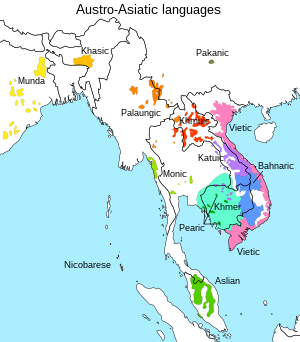
KNOWPIA
WELCOME TO KNOWPIA
Summary
The Monic /ˈmoʊnɪk/ languages are a branch of the Austroasiatic language family descended from the Old Monic language of the kingdom of Dvaravati in what is now central Thailand. The Nyahkur people continue directly from that kingdom, whereas the Mon are descendants of those who migrated to Pegu after the 11th century Khmer conquest of Dvaravati.
| Monic | |
|---|---|
| Geographic distribution | Indochina |
| Linguistic classification | Austroasiatic
|
Early form | |
| Subdivisions | |
| Glottolog | moni1258 |
 Monic | |
Classification edit
Paul Sidwell (2009:114) proposes the following tree ("stammbaum") for Monic, synthesizing past classifications from Theraphan L-Thongkum (1984) and Gérard Diffloth (1984).
- Old Mon / Proto-Monic
- Nyah Kur
- North
- Central
- South
- Middle Mon
- Literary Mon
- Mon Ro: Northernmost dialect, spoken in the Pegu-Paung-Zin Kyaik area
- West Mon Ro variety: Spoken from north of Martaban to Thaton
- East Mon Ro variety: Spoken in a small area on the south bank of the Gyaing River
- Mon Rao: Spoken around Mawlamyine, extending several hundred kilometers south to Tavoy
- North Mon Rao
- Kamarwet area Mon
- South Mon Rao
- Ye Mon Rao: This is the southernmost Mon variety.
- Thai Mon (mix of Mon Ro and Mon Rao)
- Nyah Kur
Proto-language edit
| Proto-Monic | |
|---|---|
| Reconstruction of | Monic languages |
Reconstructed ancestor | |
| Lower-order reconstructions |
|
Selected animal and plant names in Proto-Monic, Proto-Nyah Kur, and Proto-Mon (Diffloth 1984):[1]
Mammals edit
species Proto-Monic Proto-Nyah Kur Proto-Mon Tupaia sp. *[c/s]naaʔ *ɕhna̱aʔ Panthera tigris corbetti *klaaʔ *khla̱aʔ *kla̱ʔ Lutrogale perspicillata, Lutra lutra nair *phɛɛʔ *phɛ̱ɛʔ *phɛ̱ʔ Bos gaurus readei *kndiiŋ *kənti̤iɲ *kəlɤ̱i̯ɲ Rusa unicolor equinus *tɓuŋ *thbu̱ŋ *ɓɒ̱ɨ̯ŋ Rucervus eldii thamin, Cervus eldi siamensis *[r]maŋ *ləma̤ŋ *mɛ̤a̯ŋ Muntiacus muntjak vaginalis, Muntiacus feae *pas *pa̱j̊ *pɔ̱h Hystrix hodgsoni *lmliəŋ *ləmli̤aŋ *pəli̤ə̯ŋ Ursus thibetanus *kmu̱m *khmu̱m *[k]hmi̱m
Birds edit
species Proto-Monic Proto-Nyah Kur Proto-Mon Corvus splendens *klʔaak *kəlʔa̱ak *həɗa̱i̯c Caprimulgus macrurus *klwaaʔ *kəwa̱aʔ *kəwa̱ʔ Caprimulgus macrurus? *ʔ[m]blak *bla̱k *ʔəplɛ̤a̯k Spizaetus sp. *liŋ-liəŋ *liŋ-li̤aŋ *kəni̤ə̯ŋ Gallus gallus *tjaaŋ *chja̱aŋ *ca̱i̯ɲ Psittacula eupatria avensis, Psittacula finschii? *kreeɲ *krə̱əɲ *krʌ̱i̯ɲ Coturnix sp. *cgɯt *cəkɯ̤t *hək[i̤/ɯ̤]t Pseudogyps bengalensis? *t-[m]-maat *tə(m)ma̱at *[k]əma̱t Oriolus chinensis? *mit *mɯ̤t *mi̤t Treron phoenicopterus viridifrons *prgum *pərkṳm *həkə̤m Eudynamis scolopacea malayana *t[]wa(a)w *t()wa̱w *kəwa̱o̯ Streptopelia orientalis *puur *pu̱ur *pɒ̱u̯
Other animals edit
species Proto-Monic Proto-Nyah Kur Proto-Mon Periplaneta sp. *sdɛɛʔ *ɕətɛ̤ɛʔ *həte̤ʔ Apis dorsata *saaj *ɕa̱aj *sa̱i̯ Trionyx cartilageneus *dwiiʔ *[c/t]həwi̤iʔ *kwi̤ʔ Fluta alba *doŋ-nooŋ *kənto̤oŋ ~ *tṳŋ-to̤oŋ *hələ̤ɨ̯ŋ Ophiocephalus striatus *knlɔɔn *kənlu̱an *kəno̤n Varanus nebulosus *trkɔɔt *təku̱at *həko̱t
Plants edit
species Proto-Monic Proto-Nyah Kur Proto-Mon Bambusa arundinacea *ɟrlaaʔ *chəla̤aʔ *həlɛ̤ə̯ʔ Antiaris toxicaria *kɟiiʔ *kəci̤iʔ *kji̤ʔ Imperata cylindrica *cwooʔ *chwo̱oʔ *khwɒ̱ɨ̯ʔ Entada rheedii, Entada scandens *ɟnlɛɛʔ *khənlɛ̤ɛʔ *həne̤ʔ Eugenia cumini *kriəŋ *kri̱aŋ *kri̱ə̯ŋ Dipterocarpus alatus, Dipterocarpus turbinatus *g[]jaaŋ *khəja̤aŋ *həja̤i̯ɲ Pentace burmanica *sit-siət *ɕit-ɕi̱at *kəsə̱t Berrya mollis *klwaan *kəlwa̱an *kəlwa̱an Spondias mangifera *[k]ʔiil *[kh]əʔi̱il *ʔi̱ Ficus bengalensis, Ficus religiosa *ɟrəj *chrə̤j *sɔ̤e̯ Phyllanthus emblica *trluuj *təlu̱uj *kəlu̱i̯
Lexical innovations edit
Selected Monic lexical innovations:[2]
| Gloss | Proto-Austroasiatic | Proto-Monic | Old Mon | Nyah Kur |
|---|---|---|---|---|
| ‘knee’ | *psaɲ | *ɟroːm | – | chròːm |
| ‘money’ | *swaːʔ | *knuːj | knuj | khǝnúːj |
| ‘chicken’ | *ʔiər | *tjaːŋ | tyaiŋ | cháːŋ |
| ‘dog’ | *cɔːʔ | *clur | kløw | chúr |
See also edit
- List of Proto-Monic reconstructions (Wiktionary)
- Mon language
- Nyah Kur language
Footnotes edit
- ^ Diffloth, Gérard. 1984. The Dvaravati Old Mon languages and Nyah Kur. Monic Language Studies. Chulalongkorn University Printing House, Bangkok.
- ^ Sidwell, Paul (2021). "Classification of MSEA Austroasiatic languages". The Languages and Linguistics of Mainland Southeast Asia. De Gruyter. pp. 179–206. doi:10.1515/9783110558142-011.
References edit
- Sidwell, Paul (2009). Classifying the Austroasiatic languages: history and state of the art. LINCOM studies in Asian linguistics, 76. Munich: Lincom Europa.
Further reading edit
- Monic language studies. (1984). Bangkok, Thailand: Chulalongkorn University Print. House.
- Diffloth, Gérard. 1984 The Dvaravati Old Mon languages and Nyah Kur. Monic Language Studies. Chulalongkorn University Printing House, Bangkok.
- Eppele, John William, Carey Statezni, and Nathan Statezni. 2008. Monic bibliography. Chiang Mai: Payap University.
- Eppele, John William, Carey Statezni, and Nathan Statezni. 2008. Monic bibliography with selected annotations. Chiang Mai: Payap University.
- Ferlus, Michel. 1983. Essai de phonétique historique de môn. Mon-Khmer Studies 12: 1–90.
- Huffman, Franklin E. 1990. Burmese Mon, Thai Mon, and Nyah Kur: a synchronic comparison. Mon-Khmer Studies 16–17: 31–84.
External links edit
- SEAlang Project: Mon–Khmer languages: The Monic Branch
- "Monic". Archived from the original (lecture) on 2007-09-15. Retrieved 2007-09-21.
- Old Mon inscriptions


